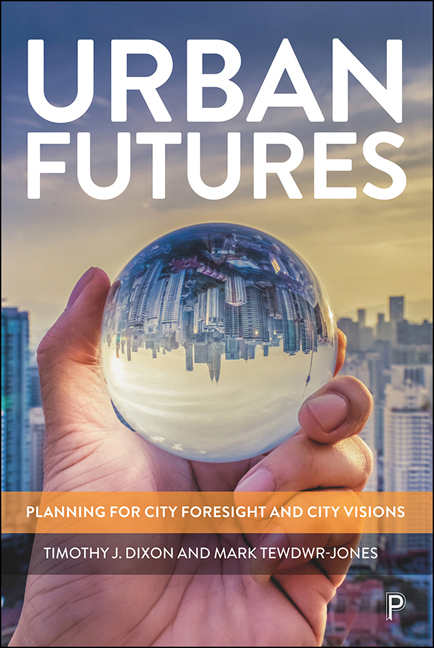Book contents
- Frontmatter
- Contents
- List of figures, tables and boxes
- Acknowledgements
- Foreword
- Preface
- 1 Urban futures: planning for city foresight and city visions
- 2 Cities and integrated urban challenges
- 3 Reimagining the city: views of the future from the past and present
- 4 Planning and governing the future city
- 5 Future narratives for the city: smart and sustainable?
- 6 Theoretical approaches to urban futures
- 7 Using city foresight methods to develop city visions
- 8 Shaping the future: city vision case studies
- 9 The innovative and experimental city
- 10 Visioning and planning the city in an urban age: a reality check
- 11 Conclusions: facing the urban future to 2050 and beyond
- Appendix: selected examples of city visions
- Notes
- References
- Index
3 - Reimagining the city: views of the future from the past and present
Published online by Cambridge University Press: 21 December 2021
- Frontmatter
- Contents
- List of figures, tables and boxes
- Acknowledgements
- Foreword
- Preface
- 1 Urban futures: planning for city foresight and city visions
- 2 Cities and integrated urban challenges
- 3 Reimagining the city: views of the future from the past and present
- 4 Planning and governing the future city
- 5 Future narratives for the city: smart and sustainable?
- 6 Theoretical approaches to urban futures
- 7 Using city foresight methods to develop city visions
- 8 Shaping the future: city vision case studies
- 9 The innovative and experimental city
- 10 Visioning and planning the city in an urban age: a reality check
- 11 Conclusions: facing the urban future to 2050 and beyond
- Appendix: selected examples of city visions
- Notes
- References
- Index
Summary
A map of the world that does not include Utopia is not worth even glancing at, for it leaves out the one country at which Humanity is always landing. And when Humanity lands there, it looks out, and, seeing a better country, sets sail. Progress is the realisation of Utopias.
Oscar Wilde, 1891Introduction
Humankind's capacity to envision the future and to be able to imagine alternative futures is a relatively recent development, relating directly to the age of enlightenment (Gidley, 2017a). Thus, ‘utopian’ thinking, founded on the work of writers such as Plato and Thomas More, was transformed during this period into ‘euchronia’ (or a time of perfect social, technological and ecological harmony), which enabled different places in different times to be imagined. The city has often been at the heart of much of the utopian and euchronian literature, film and related art that has emerged since then. As Clarke suggested: ‘For at least the past five centuries … the make-believe city has been the benchmark of all imaginary societies’ (Clarke, 1992: 702). Moreover, the resultant ‘urban imaginaries’ that have been developed have been founded on both utopic (‘good’) and dystopic (‘bad’) futures. In turn, this body of work has helped shape and influence the nature of urban design and urban planning.
In this chapter, we will first examine what is meant by the term ‘vision’ and how writers such as Plato and Thomas More have influenced our thinking about the future, through their utopian ideas. We then compare and contrast utopian and dystopian views of the future, drawing on literature and film (and related art) to examine questions such as what sort of ‘urban imaginaries’ emerge from literature and film, and do these imaginaries shape the way our cities look and feel today (and will do in the future), and vice versa? Finally, we look at the way in which utopian thinking has influenced and shaped urban planning through the visionary thinking of early thinkers such as Geddes, Howard and others.
It is important to note, however, that the chapter is not intended to be a comprehensive or exhaustive inventory or critique of all futuresbased thinkers or writers – for this the reader is referred in the general literature to authors such as Claeys (2010, 2011, 2017) and in the planning and urban design literature to other writers such as Eaton (2001), Rosenau (2010) and Hall (2014).
- Type
- Chapter
- Information
- Urban FuturesPlanning for City Foresight and City Visions, pp. 41 - 64Publisher: Bristol University PressPrint publication year: 2021



